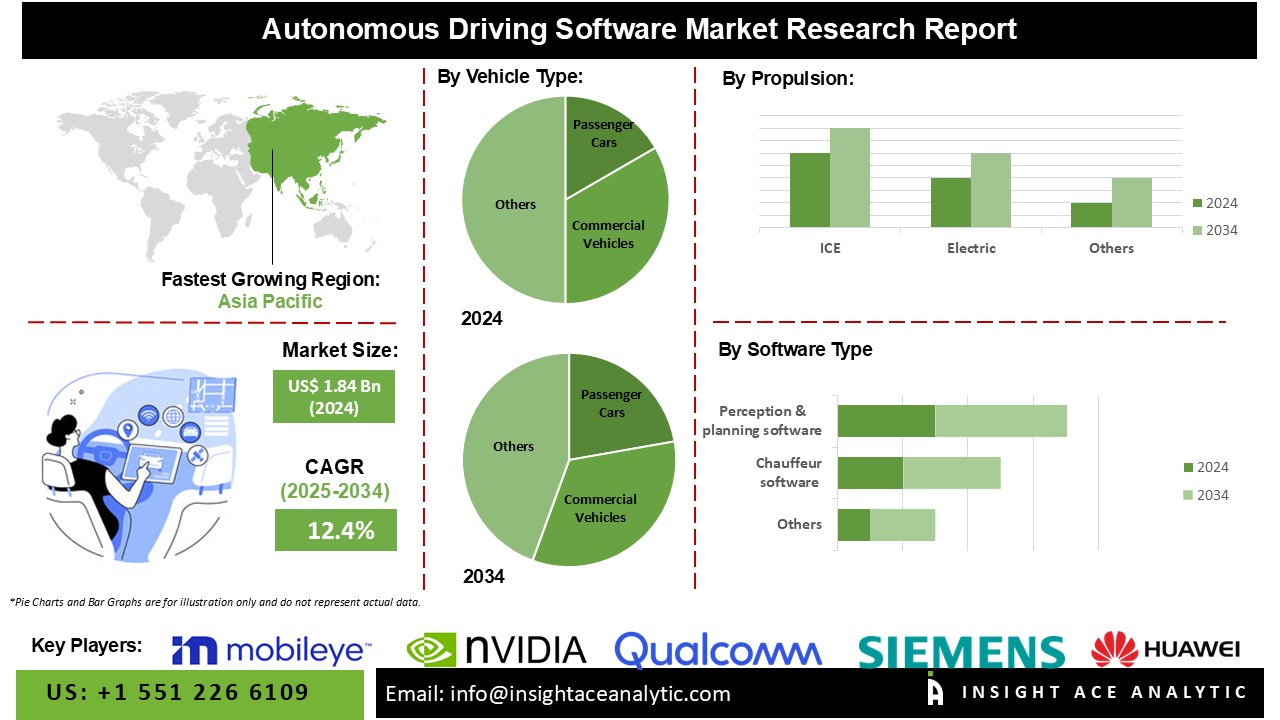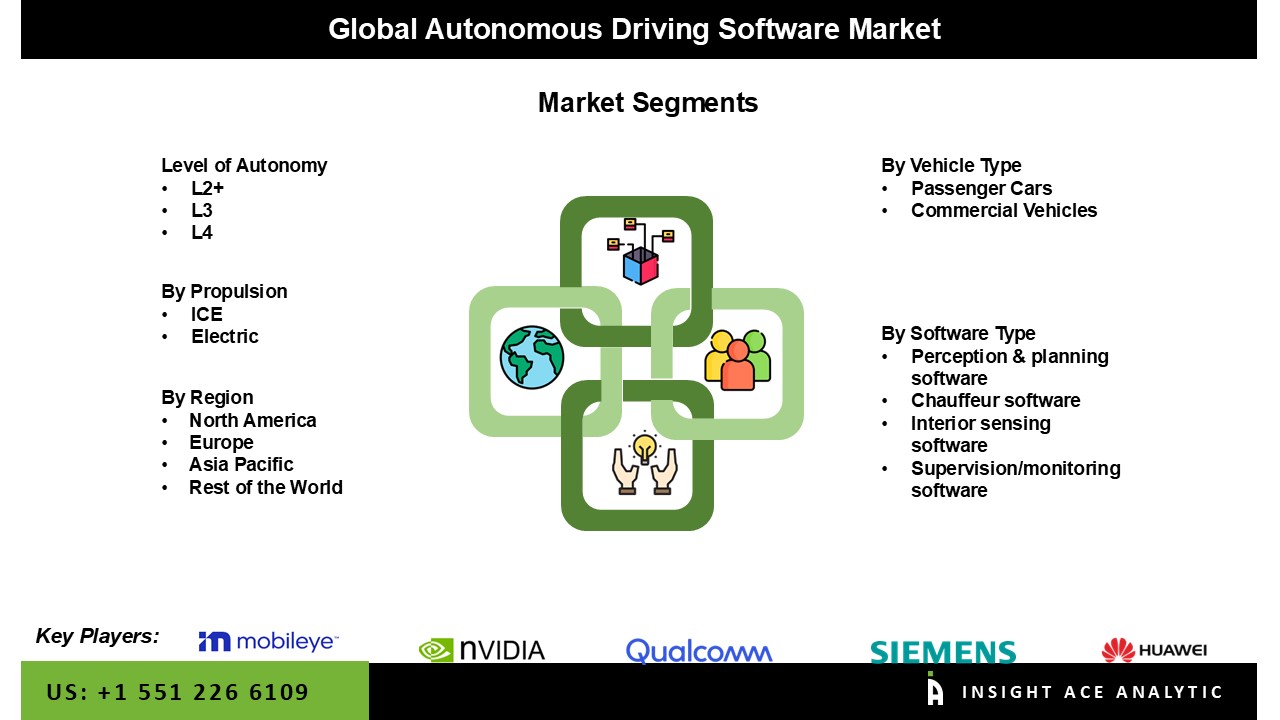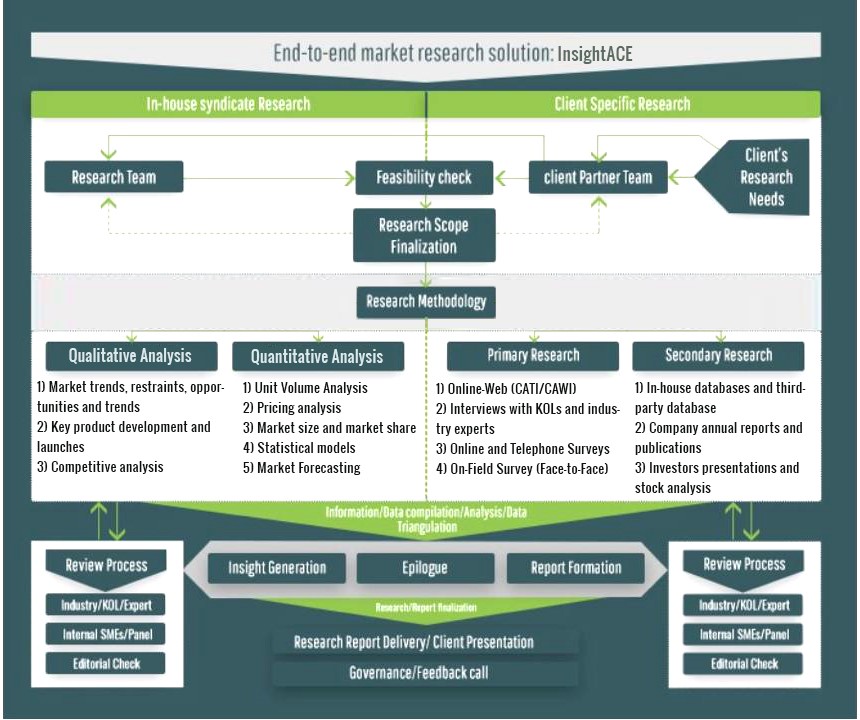Autonomous Driving Software Market Size is valued at USD 1.84 Bn in 2024 and is predicted to reach USD 5.81 Bn by the year 2034 at an 12.4% CAGR during the forecast period for 2025-2034.

The market for autonomous driving software is expanding due in large part to the growing need for safer and more effective transportation options. Automotive manufacturers are obligated to integrate safety features into their vehicles due to the worldwide enforcement of strict safety regulations. Self-driving cars, including trucks and other vehicles, are designed to operate safely without the need for a driver to take control. While designs may vary, most self-driving systems rely on a combination of sensors, such as radar, to create and maintain a detailed map of their environment.
The software processes these inputs to generate a driving path and sends commands to the vehicle’s actuators, which control steering, braking, and acceleration. To ensure safe operation, the software utilizes hard-coded rules, predictive modeling, obstacle avoidance algorithms, and intelligent object discrimination to navigate traffic laws and avoid obstacles effectively. The autopilot driving software is instantly modified by this change because it helps to comply with specific safety requirements. To ensure vehicle safety, it makes use of complex algorithms and real-time data processing.
Furthermore, because autonomous driving technologies can be seamlessly included into the electronic structures of electric vehicles, the increasing popularity of EVs supports the advancement of these technologies. Simultaneously to this, the rigorous development of advanced driver assistance system (ADAS) technology sets even greater standards for sophisticated software applications utilized by the automotive sector. Among the several automation and safety features that are part of ADAS are adaptive cruise control and lane-keeping assistance. Constant advancements in sensor fusion, AI, and machine learning (ML) technologies are driving the industry.
The Autonomous Driving Software Market is segmented based level of autonomy, vehicle type, propulsion, software type. Based on the Level of Autonomy, the market segmented into L2+, L3, L4. Based on the vehicle type, the market segmented into passenger cars, commercial vehicles. Based on Propulsion, the market segmented into, ICE, electric. Based on software type, the market segmented into perception & planning software, chauffeur software, interior sensing software, supervision/monitoring software.
Based on the level of autonomy, the market segmented into L2+, L3, L4. Among these, the L2+ solutions segment is expected to have the highest growth rate during the forecast period. This level represents partial automation, where the vehicle can control steering, acceleration, and braking in certain conditions, but the driver must be engaged and ready to take over. L2+ autonomous vehicles offer advanced driver assistance features like lane departure warning, adaptive cruise control, blind spot detection, automated emergency braking, and lane-keeping assistance. The "plus" indicates systems that offer more advanced features, such as automated lane changes or advanced cruise control. L2+ is a rapidly growing segment as it balances automation with driver control.
Based on the vehicle type, the market segmented into Passenger Cars, commercial vehicles. Among these, the passenger cars models segment dominates the market. This dominance is driven by the high adoption rate of advanced driver assistance systems (ADAS) and autonomous features in passenger vehicles. Major automotive OEMs are focusing heavily on integrating autonomous technologies into passenger cars, catering to the growing consumer demand for enhanced safety, convenience, and driving experience.
The region controls the majority of the global market because of the rising use of these cars and consumer desire for features with cutting-edge technologies. Automakers intend to extend their production networks and achieve technological advancements in developing nations like China and India. The Asia Pacific region is home to leading technology companies, automotive manufacturers, and startups that are heavily investing in autonomous driving technologies. Strong R&D capabilities, coupled with partnerships between tech firms and automakers, drive innovation and market growth.
|
Report Attribute |
Specifications |
|
Market Size Value In 2023 |
USD 1.84 Bn |
|
Revenue Forecast In 2031 |
USD 5.81 Bn |
|
Growth Rate CAGR |
CAGR of 12.4% from 2025 to 2034 |
|
Quantitative Units |
Representation of revenue in US$ Bn and CAGR from 2025 to 2034 |
|
Historic Year |
2021 to 2024 |
|
Forecast Year |
2025-2034 |
|
Report Coverage |
The forecast of revenue, the position of the company, the competitive market structure, growth prospects, and trends |
|
Segments Covered |
Level of Autonomy, Vehicle Type, Propulsion, Software Type |
|
Regional Scope |
North America; Europe; Asia Pacific; Latin America; Middle East & Africa |
|
Country Scope |
U.S.; Canada; U.K.; Germany; China; India; Japan; Brazil; Mexico; France; Italy; Spain; South Korea; South East Asia |
|
Competitive Landscape |
Autox, Cruise, Carmera, Embark Trucks, Magna International, Motional, Nauto, Mobileye, Nvidia Corporation, Tesla Inc, Siemens Ag, Qualcomm, Huawei, Aurora Innovation Ltd., Aptiv, Waymo Green Hills, Blackberry, Astemo, Cariad, Baidu, Continental Ag, Robert Bosch, Woven (By Toyota), AI Motive, Pony AI, Kpit, Oxa Autonomy Limited, Zoox, Inc., Imagry, Wayve Technologies Ltd. |
|
Customization Scope |
Free customization report with the procurement of the report and modifications to the regional and segment scope. Particular Geographic competitive landscape. |
|
Pricing and Available Payment Methods |
Explore pricing alternatives that are customized to your particular study requirements. |
Chapter 1. Methodology and Scope
1.1. Research Methodology
1.2. Research Scope & Assumptions
Chapter 2. Executive Summary
Chapter 3. Global Autonomous Driving Software Market Snapshot
Chapter 4. Global Autonomous Driving Software Market Variables, Trends & Scope
4.1. Market Segmentation & Scope
4.2. Drivers
4.3. Challenges
4.4. Trends
4.5. Investment and Funding Analysis
4.6. Industry Analysis – Porter’s Five Forces Analysis
4.7. Competitive Landscape & Market Share Analysis
4.8. Impact of Covid-19 Analysis
Chapter 5. Market Segmentation 1: Level of Autonomy Estimates & Trend Analysis
5.1. Level of Autonomy & Market Share, 2024 & 2034
5.2. Market Size (Value (US$ Mn)) & Forecasts and Trend Analyses, 2021 to 2034 for the following Level of Autonomy:
5.2.1. L2+
5.2.2. L3
5.2.3. L4
Chapter 6. Market Segmentation 2: by Vehicle Type Estimates & Trend Analysis
6.1. by Vehicle Type & Market Share, 2024 & 2034
6.2. Market Size (Value (US$ Mn)) & Forecasts and Trend Analyses, 2021 to 2034 for the following by Vehicle Type:
6.2.1. Passenger Cars
6.2.2. Commercial Vehicles
Chapter 7. Market Segmentation 3: by Propulsion Estimates & Trend Analysis
7.1. by Propulsion & Market Share, 2024 & 2034
7.2. Market Size (Value (US$ Mn)) & Forecasts and Trend Analyses, 2021 to 2034 for the following by Propulsion:
7.2.1. ICE
7.2.2. Electric
Chapter 8. Market Segmentation 4: by Software Type Size Estimates & Trend Analysis
8.1. By Software Type Size & Market Share, 2024 & 2034
8.2. Market Size (Value (US$ Mn)) & Forecasts and Trend Analyses, 2021 to 2034 for the following By Software Type Size:
8.2.1. Perception & Planning Software
8.2.2. Chauffeur Software
8.2.3. Interior Sensing Software
8.2.4. Supervision/Monitoring Software
Chapter 9. Autonomous Driving Software Market Segmentation 5: Regional Estimates & Trend Analysis
9.1. North America
9.1.1. North America Autonomous Driving Software Market Revenue (US$ Million) Estimates and Forecasts Level of Autonomy, 2021-2034
9.1.2. North America Autonomous Driving Software Market Revenue (US$ Million) Estimates and Forecasts by Vehicle Type, 2021-2034
9.1.3. North America Autonomous Driving Software Market Revenue (US$ Million) Estimates and Forecasts by Propulsion, 2021-2034
9.1.4. North America Autonomous Driving Software Market Revenue (US$ Million) Estimates and Forecasts by Software Type Size, 2021-2034
9.1.5. North America Autonomous Driving Software Market Revenue (US$ Million) Estimates and Forecasts by country, 2021-2034
9.2. Europe
9.2.1. Europe Autonomous Driving Software Market Revenue (US$ Million) Estimates and Forecasts Level of Autonomy, 2021-2034
9.2.2. Europe Autonomous Driving Software Market Revenue (US$ Million) Estimates and Forecasts by Vehicle Type, 2021-2034
9.2.3. Europe Autonomous Driving Software Market Revenue (US$ Million) Estimates and Forecasts by Propulsion, 2021-2034
9.2.4. Europe Autonomous Driving Software Market Revenue (US$ Million) Estimates and Forecasts by Software Type Size, 2021-2034
9.2.5. Europe Autonomous Driving Software Market Revenue (US$ Million) Estimates and Forecasts by country, 2021-2034
9.3. Asia Pacific
9.3.1. Asia Pacific Autonomous Driving Software Market Revenue (US$ Million) Estimates and Forecasts Level of Autonomy, 2021-2034
9.3.2. Asia Pacific Autonomous Driving Software Market Revenue (US$ Million) Estimates and Forecasts by Vehicle Type, 2021-2034
9.3.3. Asia-Pacific Thermal Cyclers Asia-Pacific Autonomous Driving Software Market Revenue (US$ Million) Estimates and Forecasts by Propulsion, 2021-2034
9.3.4. Asia-Pacific Autonomous Driving Software Market Revenue (US$ Million) Estimates and Forecasts by Software Type Size, 2021-2034
9.3.5. Asia Pacific Autonomous Driving Software Market Revenue (US$ Million) Estimates and Forecasts by country, 2021-2034
9.4. Latin America
9.4.1. Latin America Autonomous Driving Software Market Revenue (US$ Million) Estimates and Forecasts Level of Autonomy, 2021-2034
9.4.2. Latin America Autonomous Driving Software Market Revenue (US$ Million) Estimates and Forecasts by Vehicle Type, 2021-2034
9.4.3. Latin America Autonomous Driving Software Market Revenue (US$ Million) Estimates and Forecasts by Propulsion, 2021-2034
9.4.4. Latin America Autonomous Driving Software Market Revenue (US$ Million) Estimates and Forecasts by Software Type Size, 2021-2034
9.4.5. Latin America Autonomous Driving Software Market Revenue (US$ Million) Estimates and Forecasts by country, 2021-2034
9.5. Middle East & Africa
9.5.1. Middle East & Africa Autonomous Driving Software Market Revenue (US$ Million) Estimates and Forecasts Level of Autonomy, 2021-2034
9.5.2. Middle East & Africa Autonomous Driving Software Market Revenue (US$ Million) Estimates and Forecasts by Vehicle Type, 2021-2034
9.5.3. Middle East & Africa Autonomous Driving Software Market Revenue (US$ Million) Estimates and Forecasts by Propulsion, 2021-2034
9.5.4. Middle East & Africa Autonomous Driving Software Market Revenue (US$ Million) Estimates and Forecasts by Software Type Size, 2021-2034
9.5.5. Middle East & Africa Autonomous Driving Software Market Revenue (US$ Million) Estimates and Forecasts by country, 2021-2034
Chapter 10. Competitive Landscape
10.1. Major Mergers and Acquisitions/Strategic Alliances
10.2. Company Profiles
10.2.1. Autox
10.2.2. Cruise
10.2.3. Carmera
10.2.4. Embark Trucks
10.2.5. Magna International
10.2.6. Motional
10.2.7. Nauto
10.2.8. Mobileye
10.2.9. Nvidia Corporation
10.2.10. Tesla Inc
10.2.11. Siemens Ag
10.2.12. Qualcomm
10.2.13. Huawei
10.2.14. Aurora Innovation Ltd.
10.2.15. Aptiv
10.2.16. Waymo
10.2.17. Green Hills
10.2.18. Blackberry
10.2.19. Astemo
10.2.20. Cariad
10.2.21. Baidu
10.2.22. Continental Ag
10.2.23. Robert Bosch
10.2.24. Woven (By Toyota)
10.2.25. Ai Motive
10.2.26. Pony Ai
10.2.27. Kpit
10.2.28. Oxa Autonomy Limited
10.2.29. Zoox, Inc.
10.2.30. Imagry
10.2.31. Wayve Technologies Ltd.
Global Autonomous Driving Software Market - Level of Autonomy

Global Autonomous Driving Software Market – By Vehicle Type
Global Autonomous Driving Software Market – Based on Propulsion
Global Autonomous Driving Software Market – By Software Type
Global Autonomous Driving Software Market – By Region
North America-
Europe-
Asia-Pacific-
Latin America-
Middle East & Africa-
InsightAce Analytic follows a standard and comprehensive market research methodology focused on offering the most accurate and precise market insights. The methods followed for all our market research studies include three significant steps – primary research, secondary research, and data modeling and analysis - to derive the current market size and forecast it over the forecast period. In this study, these three steps were used iteratively to generate valid data points (minimum deviation), which were cross-validated through multiple approaches mentioned below in the data modeling section.
Through secondary research methods, information on the market under study, its peer, and the parent market was collected. This information was then entered into data models. The resulted data points and insights were then validated by primary participants.
Based on additional insights from these primary participants, more directional efforts were put into doing secondary research and optimize data models. This process was repeated till all data models used in the study produced similar results (with minimum deviation). This way, this iterative process was able to generate the most accurate market numbers and qualitative insights.

Secondary research
The secondary research sources that are typically mentioned to include, but are not limited to:
The paid sources for secondary research like Factiva, OneSource, Hoovers, and Statista
Primary Research:
Primary research involves telephonic interviews, e-mail interactions, as well as face-to-face interviews for each market, category, segment, and subsegment across geographies
The contributors who typically take part in such a course include, but are not limited to:
Data Modeling and Analysis:
In the iterative process (mentioned above), data models received inputs from primary as well as secondary sources. But analysts working on these models were the key. They used their extensive knowledge and experience about industry and topic to make changes and fine-tuning these models as per the product/service under study.
The standard data models used while studying this market were the top-down and bottom-up approaches and the company shares analysis model. However, other methods were also used along with these – which were specific to the industry and product/service under study.